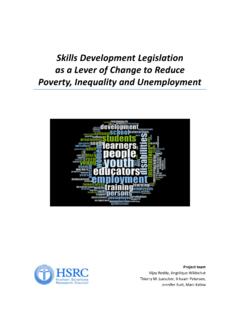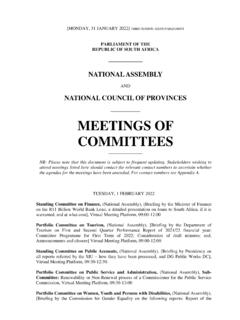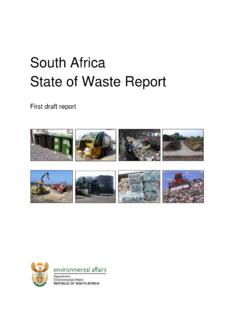Transcription of Poverty in Perspective Statistics South Africa
1 Poverty in PerspectiveStatistics South AfricaContextualizing Poverty and Inequality in the WC, with further emphasis on thegenerational and endemic nature of Poverty as it affects women and the girl child in the WCSouth Africa s population, mid-2020 is59,62 million215,49 M11,53 M7,01 M6,73 M5,85 M4,68 M4,11 M2,93 M1,29 M25,8%GPKZNWCECLPMPMore than half of the population live in 3 provinces (GP,KZN and WC)WChas close to 7 million inhabitants26,0%19,3%11,8%11,3%9,8%7,8%6 ,9%4,9%2,2%NWFSNC57,1%Mid-year population estimates for South Africa by province, 20203 The districts shown represented around 11% of the population of WCMid Year Population Estimates for 2021 District Projections based on 2020 Series449,3%50,7%Approximately 50,7% of the population in the WC is population, mid-2020 by sexSource.
2 Mid-year population estimates for South Africa by province, 2020549,4%47,2%49,5%50,5%49,5%47,8%50,6% 52,8%50,5%49,5%50,5%52,2%WC - cape Winelands District Municipality (DC2)WC - Central Karoo District Municipality (DC5)WC - City of cape Town Metropolitan MunicipalityWC - Overberg District Municipality (DC3)WC - West Coast District Municipality (DC1)WC- Garden Route (DC4)Overberg DM has a slightly lower proportion of Females than malesMid Year Population Estimates District Projections based on 2020 Series624,5%27,7%28,6%31,1%31,5%32,4%35, 2%36,1%36,6%39,2%8,5%10,3%9,1%9,9%9,0%10 ,2%8,1%7,9%11,4%8,9%GPWCSAFSNWNCKZNMPECL PC hildren under 15 within each provinceElderly (60+) within each province67,0%62,0%62,3%59,0%59,5%57,4%56 ,6%56,0%52,0%51,8%Youth and AdultWC has around 62% Youth and Adults (15-59) within the ProvincePopulation by age category and province, 20207 Source: Stats SA.
3 Mid-year population estimates 2018 41,0%49,1%45,0%44,2%42,5%42,0%46,5%40,0% 32,2%36,3%20,7%19,8%29,1%29,6%31,3%32,7% 25,6%38,3%52,9%48,5%3,7%5,7%2,4%4,0%2,9% 4,0%5,4%2,4%3,2%3,6%34,6%25,5%23,5%22,2% 23,4%21,3%22,4%19,2%11,8%11,5%ECKZNLPFSN WRSAMPNCGPWCN ationally, 42 per cent lived with mothers had the lowest proportion of children living with neither parentChildren in affluent provinces were most likely to live with both parents. Children's living arrangements was likely to affect their performance at school. Lived with neitherLived with motherLived with bothLived with fatherPercentage of children living arrangements, 2019815,5%17,6%22,0%22,7%23,4%26,9%27,0% 28,5%29,7%34,4%31,7%20,6%40,6%41,9%40,6% 38,4%48,4%49,6%53,6%54,4%GPWCRSAMPKZNNCN WFSLPECF emaleMale20,6% of Female headed households in WC do not have an employed household memberHouseholds without and employed household member by sex of household head, 20109 Source: Marginal Groups Indicator Report 20199Of those employed in the WC Females accounted for 41,3% of those in ManagerialoccupationsSource: QLFS Q4.
4 202010100,041,216,18,311,350,176,757,845 ,641,345,958,883,991,788,749,923,342,254 ,458,754,10,010,020,030,040,050,060,070, 080,090,0100,0 Domestic worker Elementary Plant and machine operator Craft and related trade Skilled agriculture Sales and services Clerk Technician Professional ManagerTotalWomenMenAround 21%of WC Population is considered poor based on the Lower Bound Poverty Line.(Money metric Poverty )Source: Poverty Trend ReportThreshold of absolute deprivation. The amount of money required to purchase the minimum required daily energy intakeFood Poverty LineR585 Austere threshold below which one has to choose between food and important non-food itemsLower-Bound Poverty LineR840 Upper-Bound Poverty LineR1268 Threshold of relative deprivation below which people cannot afford the minimum desired lifestyle by most South Africans* Based on April 2020 pricesSource: National Poverty Lines 12 Upper-Bound Poverty LineLower-Bound Poverty LineFood Poverty LineSource.
5 Living Conditions SurveyIs the Rand value below which individuals are unable to purchase or consume enough foodto supply them with minimum per-capita-per-day energy requirement for good healthProvides an austere threshold below which one has to choose between food and important non-food itemsProvides an unambiguous threshold of relative deprivation below which people cannot afford the minimum lifestyle desired by most South AfricansNational FigureWCMoney-metric Povertyheadcounts in 2015 Non Poor-62,9%Poor-37,1%Non Poor-78,7%Poor-21,3%Non Poor-90,0%Poor-10,0%13 TheSouth African Multidimensional Poverty indicators provide a more holistic view of Poverty 14 HealthEducationChild mortalityYears of schoolingSchool attendanceThe four dimensions of the SAMPIL iving standardsLightingHeatingCookingWaterSani tationEconomic activityUnemploymentDwellingAssets(death of child under 5)(completed 5 years of schooling)(school-aged child out of school)(no electricity)(no electricity)(no electricity)(no piped water)(informal/traditional/caravan/tent )(no flush toilet)(no radio/TV/phone/car)(adults unemployed)
6 Deprivation cut-offs1517,9%8,0%7,0%6,7%3,6%2,7%20012 0022003200420052006200720082009201020112 0122013201420152016 RSAW estern CapeRSAM ultidimensional Poverty by Geographic Various levels 2001-2016 SAMPIS ourceThe South African MPIWC had significantly lower levels of multidimensional Poverty than the SA average over the three periods 162,64%2,90%OverbergWest CoastIn 2016 West Coast DMhad the highest rate of multidimensional Poverty of the two districts Poverty by District in WC 201617CS 201640523310 Years5 YearsMultidimensional Poverty DriversSourceThe South African MPI1839%55%70%13%11%3%38%20%10%6%11%11%4 ,435,70102030405060708090100 ECLPFSNWMPKZNNCRSAGPWCS alariesRemittancesOther SourcesGrantsPensionsPercentage distribution of sources of household income by province, 2019 Grants remain A significant source of income for SA households, particularly in rural areas.
7 70% of household income is sourced from salaries in WCSource: GHS 201919 Service Delivery20In 2019 WC was above the national average in households connected to mains electricity with 88,4%21WC had the highest levels of households with improved access to sanitation2296,5% of households in the West Coast main source of water for drinking was delivered via a piped connection WaterElectricitySanitationWest Coast96,5%94,1%92,5%Overberg97,9% 94,6%95,7%main source of water for drinking delivered via a piped connection access to a flush or chemical toilet connected to the mains electricity supplySource: Community Survey 2016.
8 23 Vulnerable Groups are defined as a part of the South African population that experience a higher risk of Poverty andsocial exclusion than the general population. Women are amongst these groups243,6%4,9%13,4%13,8%13,8%16,6%18,2 %18,6%24,1%27,9%Western CapeGautengNorth WestNorthern CapeSouth AfricaFree StateMpumalangaKwaZulu-NatalLimpopoEaste rn CapeWC has the lowest proportion of agricultural households at 3,6% within the provinceProvincial profile: Community Survey 2016], Report number 03-01-15253,9%6,8%9,4%9,7%10,0%12,4%12,6 %14,6%16,2%18,2%4,7%9,5%6,3%11,1%13,8%11 ,1%15,5%16,4%15,4%19,0%0%2%4%6%8%10%12%1 4%16%18%20%LPGPECRSAKZNWCMPFSNWNCMaleFem aleIn 2019 WC had of female headed households that reported suffering from hunger Source.
9 Marginal Groups Indicator Report 2019 Households that reported hunger26 Percentage of households that ran out of money to buy food in the past 12 months by sex of household head, CS 2016MP MHHMP FHH12,1%11,5%15,0%12,6%14,6%11,7%15,5%15 ,0%14,4%17,2%16,6%18,2%14,1%18,5%Western CapeCPT: City of CapeTownDC1: West CoastDC2: CapeWinelandsDC3: OverbergDC4: GardenRouteDC5: CentralKarooFemale-headedhouseholdMale-h eadedhousehold18,2% of Female-headed households in Overberg DM are likely to run out of money to buy : CS 201627 Gender pay gap examined, findings from the Quarterly Labour Force Survey28In 2018 women s median monthly earnings were 76% of men's median monthly earnings 2966,2%71,4%71,4%74,3%75,0%75,0%81,6%85, 7%86,9%LimpopoNorthern CapeKwaZulu-NatalFree StateNorth WestMpumalangaGautengEastern CapeWestern CapeEarnings at ParityFemale Median Earnings moreFemale Median Earnings LessIn the WCFemales earned 86,9% of men s median monthly earnings in 2018 Median Female Earnings as a % of Median Male Earnings 2018, QLFS Source: QLFS 2018 Male Female 30 Source: Stats SA.
10 Mid-year population estimates 2018 Experience of violence 31 Source: Stats SA: Mid-year population estimates 2018 Source: SADHS 201621%17%6%8%9%2%Physical violenceEmotional ViolenceSexual violenceEver ExperiencedIn the past 12 monthsOne in five (21%) partnered women has experienced physical violenceby a partner (Ever Experienced)Experience of violence by any partner, women 18+ years 32 Source: Stats SA: Mid-year population estimates 2018 Ever-experience of partner violence is at 21% in WC for physical of physical violence by any partner, women 18+ years by province3314%14%18%19%21%21%26%30%31%Kwa Zulu-NatalLimpopoGautengNorthern CapeWestern CapeF










